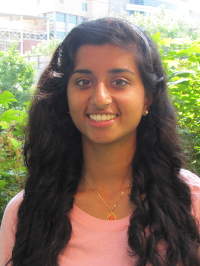2015 SRE Program Participant Profile: DIYA SASHIDHAR
 |
Hometown: Fayetteville, NC |
Why did you apply to the SRE program?
Mathematical modeling has always been interesting to me. I hoped to gain more knowledge and experience in using math to make models of various biological processes. I was particularly interested in this program because of its commitment to its participants. I liked how it provided workshops on technical skills such as R and Matlab as well as social skills such as working in a group of people with different personalities.
What is the purpose of your research?
The purpose of our project is to obtain an understanding of our body's immune response to tuberculosis and identify what factors contribute to the growth of clusters called granulomas found in this immune response.
What does the research ultimately accomplish? What contributions to science and/or humanity does the research ultimately make?
Our project is one of the first ones to try and establish an understanding of granulomas in tuberculosis based on an in vitro experiment. We are currently analyzing and modeling granulomas of Mycobacterium avium subspecies paratuberculosis (MAP) from cows with Johnnes' disease. However, we hope to be able to apply this to Mycobacterium tuberculosis in humans if we are able to create a strong model.
![]()
Sometimes, modeling can be frustrating. However, with group members come different ideas and perspectives, allowing us to progress and eventually overcome our problems.
![]()
– Diya Sashidhar, SRE participant
Describe a typical day on the job.
Our group usually meets every day. We discuss our progress and assist one another whenever we can. During the first few weeks, we read lots of papers on the bacteria and thought about factors that should be included in our model. After we established a model, we basically wrote code and determined how well the model fit the data that was provided.
Tell us something about your field of study we would be surprised to know.
Tuberculosis is one of the leading causes of death due to a bacteria pathogen and kills about 1.4 million people every year. Many of these cases involve latent infection, resulting in little to no symptoms, making it difficult to diagnosis this disease at an early stage.
What are your favorite parts of the SRE program?
I love working in groups to solve a common problem. Sometimes, modeling can be frustrating. However, with group members come different ideas and perspectives, allowing us to progress and eventually overcome our problems. I also like how our entire NIMBioS group was incredibly close and supportive. Our trips to the Great Smoky Mountains were so much fun and helped me build unforgettable experiences and friendships.
What new experiences did you gain that have helped you today?
Fortunately, NIMBioS provides workshops on a variety of topics, from Matlab to modeling basics to Latex. These workshops established a basic foundation, making it easier to hone these skills. I also learned how to think of models biologically and incorporate facts from papers into our models.
What advice would you give someone who's interested in/curious about participating in the program?
Be prepared to write and rewrite mathematical models. While it can be frustrating at times, it is important not to give up. It is incredibly satisfying to see your model fit after days of work.
Would you recommend our program to others?
Yes! It is a great program and has been a wonderful experience. I have learned so much about writing mathematical models, thinking analytically, and using software like Matlab and R to code it. I also think that my collaboration skills have improved, which will help in the future as I work with other mathematicians and scientists.
Related Links
Main SRE page
2015 summer program
NIMBioS
1122 Volunteer Blvd., Suite 106
University of Tennessee
Knoxville,
TN 37996-3410
PH: (865) 974-9334
FAX: (865) 974-9461
Contact NIMBioS


